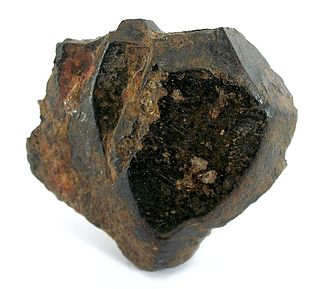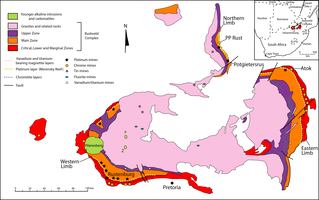
Hematite, also spelled as haematite, is a common iron oxide compound with the formula, Fe2O3 and is widely found in rocks and soils. Hematite crystals belong to the rhombohedral lattice system which is designated the alpha polymorph of Fe
2O
3. It has the same crystal structure as corundum (Al
2O
3) and ilmenite (FeTiO
3). With this it forms a complete solid solution at temperatures above 950 °C (1,740 °F).

Ilmenite is a titanium-iron oxide mineral with the idealized formula FeTiO
3. It is a weakly magnetic black or steel-gray solid. Ilmenite is the most important ore of titanium and the main source of titanium dioxide, which is used in paints, printing inks, fabrics, plastics, paper, sunscreen, food and cosmetics.

Phonolite is an uncommon shallow intrusive or extrusive rock, of intermediate chemical composition between felsic and mafic, with texture ranging from aphanitic (fine-grained) to porphyritic. Phonolite is a variation of the igneous rock trachyte that contains nepheline or leucite rather than quartz. It has an unusually high Na2O + K2O content, defining its position in the TAS classification of igneous rocks. Its coarse grained (phaneritic) intrusive equivalent is nepheline syenite. Phonolite is typically fine grained and compact. The name phonolite comes from the Ancient Greek meaning "sounding stone" due to the metallic sound it produces if an unfractured plate is hit; hence, the English name clinkstone is given as a synonym.

Nepheline syenite is a holocrystalline plutonic rock that consists largely of nepheline and alkali feldspar. The rocks are mostly pale colored, grey or pink, and in general appearance they are not unlike granites, but dark green varieties are also known. Phonolite is the fine-grained extrusive equivalent.

Kassite is a rare mineral whose chemical formula is CaTi2O4(OH)2. It crystallizes in the orthorhombic crystal system and forms radiating rosettes and pseudo-hexagonal tabular crystals which are commonly twinned. Kassite crystals are brownish pink to pale yellow in color, are translucent, and have an adamantine luster. Cleavage is distinctly visible, and the crystals are very brittle.

The Wichita Mountains are located in the southwestern portion of the U.S. state of Oklahoma. It is the principal relief system in the Southern Oklahoma Aulacogen, being the result of a failed continental rift. The mountains are a northwest-southeast trending series of rocky promontories, many capped by 500 million-year old granite. These were exposed and rounded by weathering during the Pennsylvanian & Permian Periods. The eastern end of the mountains offers 1,000 feet (305 m) of topographic relief in a region otherwise dominated by gently rolling grasslands.

Carbonatite is a type of intrusive or extrusive igneous rock defined by mineralogic composition consisting of greater than 50% carbonate minerals. Carbonatites may be confused with marble and may require geochemical verification.

Eudialyte, whose name derives from the Greek phrase Εὖ διάλυτος, eu dialytos, meaning "well decomposable", is a somewhat rare, nine member ring cyclosilicate mineral, which forms in alkaline igneous rocks, such as nepheline syenites. Its name alludes to its ready solubility in acid.
Borolanite is an historical petrological name for a pyroxene-melanite bearing nepheline syenite variety which contains nepheline-alkali feldspar pseudomorphs interpreted to be after leucite which occur as conspicuous white spots in the dark rock matrix. The rock occurs in the Borralan Igneous Complex or Loch Borralan Complex which is an alkalic igneous complex near Loch Borralan in northwest Scotland.

The Bushveld Igneous Complex (BIC) is the largest layered igneous intrusion within the Earth's crust. It has been tilted and eroded forming the outcrops around what appears to be the edge of a great geological basin: the Transvaal Basin. It is approximately 2 billion years old and is divided into four different limbs: the northern, southern, eastern, and western limbs. The Bushveld Complex comprises the Rustenburg Layered suite, the Lebowa Granites and the Rooiberg Felsics, that are overlain by the Karoo sediments. The site was first discovered around 1897 by Gustaaf Molengraaff.

A layered intrusion is a large sill-like body of igneous rock which exhibits vertical layering or differences in composition and texture. These intrusions can be many kilometres in area covering from around 100 km2 (39 sq mi) to over 50,000 km2 (19,000 sq mi) and several hundred metres to over one kilometre (3,300 ft) in thickness. While most layered intrusions are Archean to Proterozoic in age, they may be any age such as the Cenozoic Skaergaard intrusion of east Greenland or the Rum layered intrusion in Scotland. Although most are ultramafic to mafic in composition, the Ilimaussaq intrusive complex of Greenland is an alkalic intrusion.
The Windimurra Igneous Complex is a giant ultramafic-mafic intrusion emplaced within the Yilgarn craton of Western Australia. It is located approximately 100 kilometres south east of the town of Mount Magnet.
Magnet Cove is a census-designated place (CDP) and former town in Hot Spring County, Arkansas, United States. It is located in the Ouachita Mountains southeast of Hot Springs, on Arkansas Highway 51 north of U.S. Highway 270. As of the 2020 census, the town of Magnet Cove had a population of 692.

Larvikite is an igneous rock, specifically a variety of monzonite, notable for the presence of thumbnail-sized crystals of feldspar. These feldspars are known as ternary because they contain significant components of all three endmember feldspars. The feldspar has partly unmixed on the micro-scale to form a perthite, and the presence of the alternating alkali feldspar and plagioclase layers give its characteristic silver-blue schiller effect on polished surfaces. Olivine can be present along with apatite, and locally quartz. Larvikite is usually rich in titanium, with titanaugite and/or titanomagnetite present.
Mars may contain ores that would be very useful to potential colonists. The abundance of volcanic features together with widespread cratering are strong evidence for a variety of ores. While nothing may be found on Mars that would justify the high cost of transport to Earth, the more ores that future colonists can obtain from Mars, the easier it would be to build colonies there.

Rutan Hill is the local name for a hill on the United States Geological Survey Branchville 7.5-minute map. It is located about 2.46 miles (3.96 km) south-southwest of Colesville, New Jersey in the Wantage Township, of Sussex County, New Jersey in the United States. Rutan Hill rises about 270 feet (82 m) above the adjacent creek valley to an elevation of just over 1,020 feet (310 m). This hill lies entirely within private, posted property. This nondescript hill is the surface expression of a diatreme that is the northern part of the Late Ordovician Beemerville Alkaline Complex.

Nelsonite is an igneous rock primarily constituted of ilmenite and apatite, with anatase, chlorite, phosphosiderite, talc and/or wavellite appearing as minor components. Rocks are equigranular with a grain size around 2 - 3 mm. The black ilmenite is slightly magnetic while the whitish apatite is not.

Granite Mountain is an igneous intrusion southeast of Little Rock, Arkansas. Despite being named after granite, the rock at Granite Mountain is actually syenite, a rock that is visually similar to granite, but contains much less quartz. The rock was formed in the Cretaceous period around 90 million years ago, after the lamproites at Prairie Creek and the later Magnet Cove complex, and before the formation of the Monroe Uplift and Jackson Dome.

Malhmoodite is a phosphate mineral first discovered at a mine called Union Carbide in Wilson Springs, Arkansas, United States. This mine is 10 km west of Magnet Cove, an alkaline igneous complex, and Union Carbide is in a contact region of alkalic igneous rocks and surrounding sedimentary rocks. The mineral has been approved by the Commission on New Minerals and Mineral Names, IMA, to be named for the late Bertha K. Malhmood, the Administrative Assistant of the Branch of Analytical Laboratories, U.S. Geological Survey.

The Siilinjärvi carbonatite complex is located in central Finland close to the city of Kuopio. It is named after the nearby village of Siilinjärvi, located approximately 5 km west of the southern extension of the complex. Siilinjärvi is the second largest carbonatite complex in Finland after the Sokli formation, and one of the oldest carbonatites on Earth at 2610±4 Ma. The carbonatite complex consists of a roughly 16 km long steeply dipping lenticular body surrounded by granite gneiss. The maximum width of the body is 1.5 km and the surface area is 14.7 km2. The complex was discovered in 1950 by the Geological Survey of Finland with help of local mineral collectors. The exploration drilling began in 1958 by Lohjan Kalkkitehdas Oy. Typpi Oy continued drilling between years 1964 and 1967, and Apatiitti Oy drilled from 1967 to 1968. After the drillings, the laboratory and pilot plant work were made. The mine was opened by Kemira Oyj in 1979 as an open pit. The operation was sold to Yara in 2007.
















